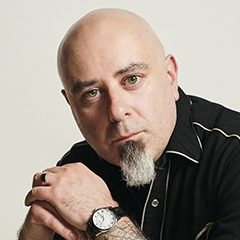Interview
INTERVIEW WITH OSCAR BETTISON
For people that don’t know the composer Oscar Bettison, what would you tell them
about yourself?
Well, I think you can read my bio in a few places if you want to, so I won’t recap that here. I’ll just say that I am a musician who writes music. I prefer that to “composer”, but composer is the easiest word for what I do. I suppose you could say I’m a bit of a wanderer. I was born in Jersey, which, is sort of, but not exactly part of the UK. My father is English and my mother is Spanish. I went to school in the UK when I was ten, I lived in Holland for a few years, and in the US for a lot longer, so I’ve moved around a bit. I don’t know what that says about me, but there it is.
Can you tell us something about the background/evolution of [fig.3]?
It was originally written for Musikfabrik, the German new music ensemble, for a project involving animation based on old cartoon strips. So, the title [fig.3] comes from the idea of illustrations in books, and it was the third piece in the set that I wrote.
The interactive webpage/video of [fig.3] shines more light on the architecture of your piece. How would you describe it orally?
Well, the piece is really something of a machine. One that breaks down a bit, but it rouses itself. It starts off with a pretty high degree of intensity, and it gets more intense towards the end. Oh, I should mention that this machine is a bit off-kilter. My favourite type of machine.
Originally, [fig.3] is written for Musikfabrik, to be performed in a classical/traditional concert setting. So, 1. How was it to make the 9×13 arrangement? And 2. How does the addition of theatrical/narrative elements and choreography change your piece from an audience perspective?
It wasn’t too difficult to make the arrangement. I actually think it works better in this context. I had a lot of fun making it, and when Anton approached me about a piece for 9×13, I knew this would work well. As I say, I think it’s actually better in this arrangement. The theatrical/narrative elements add another element to the piece, that’s really quite fun. Actually, for me, I can’t believe that the group can play this piece by memory, I should add, and then to do the choreography as well. It’s pretty amazing that that’s actually possible, but they do it so well, it’s perfectly integrated, so it’s truly remarkable. When Anton told me the plan, half of me thought he was mad, but then I know him so well and trust that if he has a plan, it will work, and well, you can see for yourselves that it did.
Your history with band leader Anton van Houten, and also with some of the performing musicians, goes far back. How would you describe the working relationship, and what role does the substantial shared history play in this?
Yes, speaking of Anton! Well, as I said, we go back a long way. Twenty years or so – that’s around half our lives! I’ve written so much music for Anton, and when I think of the trombone, I sometimes hear his sound in my mind, regardless of who I’m writing for. So, these relationships change you as a composer and I’m sure as a performer too. I think that’s what music making is, in its purest form. I said above that I think of myself as a musician who writes music. So, this pure form of music making, when whatever I do, I always end up coming back and working with the same people – in Anton’s case in Ensemble Klang but also here in 9×13- is a wonderful thing. We’re also very good friends too, so it’s always a pleasure to work together, and also to partake of his fine Scotch collection.
What drives you as a composer? Can you tell us what you enjoy most about composing and maybe with what part you struggle most?
What drives me most about composition is that it feels natural to me, but I also find it very difficult. It’s not like things get easier, it’s just that basic things become second nature, and you then find out what you don’t know and the cycle begins again, just at some higher level. There’s nothing quite like it, for me – how can something feel so natural, but it also is so difficult/ require so much work? The drive is the fascination with that dilemma, I suppose.
We hope to reach out to a lot of amateur HaFaBra musicians. What would you want to say to them before/when they experience fig.3?
It’s a fun piece, it’s heavy, hard work, but it’s meant to be fun. I think you can see that 9×13 are having fun playing it, despite its obvious difficulties.
How do you view the Dutch cultural scene as a foreigner, also given your ‘Dutch period’ of being a composition student in The Hague?
I think the Dutch cultural scene is vibrant, and constantly innovative. As a foreigner, it’s amazing that such a small country can carry so much cultural weight, but not in a historical way, like I say it’s constantly evolving. I am indeed a foreigner, but one who knows The Netherlands very well. I lived here, studied here, and I do a lot of work here. In truth, The Netherlands is to me, in many ways, my cultural home. So I am very biased!
